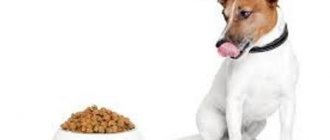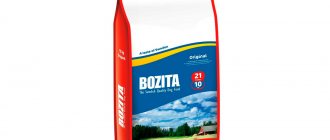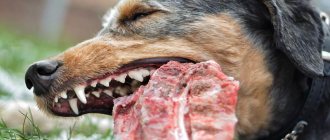The basis of any dog’s diet is meat of various types, since canines are carnivorous animals capable of obtaining microelements mainly from animal food. But not all meat is equally beneficial for pets. Some can only be given boiled, others are not suitable for animals with certain health conditions, and the third is ideal for everyone except allergy sufferers.
Any owner should understand what is allowed for a pet and what is not, and what can be replaced if necessary.
Serving sizes
Puppies are taught to eat meat from the first weeks of life. Quickly maturing representatives of dwarf breeds already from 2.5 weeks happily eat finely chopped beef, and large individuals begin to eat foods of this type from 3-4 weeks.
It is extremely important to maintain the required concentration of the meat component in the daily diet, because if it lacks protein, then not only the appearance, but also the muscles and bone skeleton will suffer.
On average, a pet should consume 20 grams of flesh per 1 kg of its weight per day. For active or small children, this figure is higher: from 30 grams per 1 kg. But over the course of life the ratio changes. So for dogs living on the street or often walking in winter, the norm is an 80% meat diet.
What is the harm of meat for a pet?
Not all meat dishes are recommended for dogs. A fatty product worsens the liver, overloads the digestive system, causing diseases of the gastrointestinal tract. Pork is the least common food eaten by pets; consuming it raw is at risk of contracting infections and parasites; you should also be careful when handling unprocessed meat from wild animals.
Harmful microorganisms are also found in other types of meat that are not heat-treated; questionable products are boiled or frozen. Each owner chooses for himself whether to keep his pet on a raw diet or feed him cooked food. It is believed that a dog’s stomach produces a sufficient level of hydrochloric acid, which has a disinfecting effect, so some dog owners feed their dogs the raw product without worry. A dog can become infected with parasites or infectious diseases on the street or from contact with sick animals. In order to minimize the risk of infection, they follow preventive measures - periodic deworming and timely vaccination.
Some types of meat provoke allergic symptoms; especially sensitive individuals may find it difficult to find an alternative; owners have to switch to special hypoallergenic foods.
The product consumed as food must be unspoiled, otherwise there is a risk of poisoning - vomiting and diarrhea, indigestion, and painful condition of the dog.
Do I need to cook it or is it better raw?
By nature, dogs are predators, which means their digestive tract is designed in such a way as to take all the substances necessary for life mainly from the raw flesh of other animals, so it is not surprising that a decent part of a pet’s diet is not heat-treated.
The dog's food consists entirely of raw meat, provided that it has been well frozen before consumption at a temperature below -20, which can only be achieved with special equipment. Therefore, if you buy fresh at the market, then for the safety of your dog, you should still cook it.
There are also some foods that simply need to be processed before consumption:
- Wild animals and birds caught by hunting are given boiled, since it is unknown what they could be sick with, and most pathogens die only at very low or very high temperatures.
- the liver and kidneys must be at least doused with boiling water, since these two organs are responsible for filtering dangerous substances and may contain not the most pleasant surprises.
- It is also better to cook the bird . This will remove small tubular bones that are dangerous for the dog, as well as get rid of the negative effects of hormones and some substances included in the composition.
Otherwise, the raw version is healthier and more enjoyable for most.
What should you consider when feeding dogs raw and cooked meat?
Meat of farm animals and, normally, game are subject to mandatory control by veterinary and sanitary inspection bodies. Therefore, they can be considered non-infectious. However, for additional safety, such meat should be scalded before serving . After all, it is difficult to prevent the entry of pathogenic microbes into meat from the external environment during its storage, transportation and sale. Before scalding, the meat must be chopped.
Raw meat contains more digestible protein and available energy than cooked meat. Therefore, if the meat had to be boiled for the above reasons, then it should be given twice as much as is usually fed raw.
Broth for a dog is not as beneficial as for a person. It can only be used if there is no worthy meat substitute.
In general, giving raw meat to dogs is not only possible, but also necessary, if you properly combine it with other types of food. By adding grains and vegetables to various sources of protein, as well as using natural vitamin and mineral supplements, you can create an excellent diet for your faithful friend.
Diet variety
In the wild, canines eat a fairly varied diet. They can easily chew any mammal they come across while hunting. Their domesticated brothers can also afford to eat quite varied, however, taking into account some features of each individual type:
- Beef is the base for any domestic dog. This is what is given to dogs, ranging from dwarf Chihuahuas to Alabai and St. Bernards. They don’t need tenderloin or any elite varieties; most often they are even harmful. But the most common, better yet tough, grade 1 beef is ideal for daily feeding, the main thing is to choose pieces that are not overgrown with fat.
- Lamb is a great alternative, but a bit heavy. It contains B vitamins, magnesium and potassium, which improve the functioning of the cardiovascular system. Lamb is considered fatty, but it contains much less cholesterol than beef.
- Horse meat is excellent in composition, but quite dangerous. Firstly, this is dietary meat, which contains easily digestible protein and is low in carbohydrates and fat. If the pet is a lazy homebody, then this choice is suitable, but if the pet is more active, the energy received will not be enough. Horse meat is digested 8 times faster than other types, so it is good to feed it when recovering from illness. The absence of allergies is also a definite plus. However, the almost complete absence of carbohydrates makes horse meat an ideal environment for the proliferation of pathogenic bacteria, so it is not recommended to feed it raw, not frozen. It is better to cook and cut into small pieces.
- Venison is an ideal, but unaffordable solution for most. It is surprisingly rich in vitamin B1, is perfectly absorbed, provides an incredible amount of energy, and does not cause allergies or diarrhea. In addition, venison improves the condition of internal organs and the digestive system. But it is almost impossible to get it in the middle zone or in the south of our country.
- Rabbit meat is a great option. If the dog is completely healthy, then nutritious rabbit meat, filled with a unique combination of vitamins and minerals, will allow you to maintain health and a flourishing appearance for a long time, since it is extremely useful for the functioning of almost all internal organs and improving the exterior of the animal.
What are the benefits of meat for dogs?
The product is important for the normal functioning of internal organs and the musculoskeletal system, immunity and appearance of the animal, it is considered a source of protein necessary for the energy and health of the dog. Natural products do not contain harmful preservatives, food additives, flavors and other dubious components.
Beef rarely causes an allergic reaction, is rich in vitamins and amino acids, and contains iron, which is important for maintaining normal blood hemoglobin levels.
Among poultry meat, turkey is preferable; it contains calcium, magnesium, potassium and other important vitamins and minerals, and has few harmful fats. Turkeys are raised without the use of hormones or antibiotics.
Rabbit meat is considered a dietary product and is given to overweight dogs.
Horsemeat is easily digestible, low-fat, suitable for overweight dogs, but not everyone will like the taste, many dogs refuse it.
Venison is considered a delicacy and is a healthy food for dogs, but its cost allows not all owners to pamper their pets.
Lamb is suitable for almost all animals, is rich in B vitamins, is considered hypoallergenic, and is a good alternative to beef in terms of iron content.
Pork is given to dogs once a week in winter to accumulate fat.
Raw large bones are beneficial; by gnawing them, the dog cleans plaque from the teeth.
What's harmful?
Not everything in the world is equally useful. This axiom is also true for our little brothers. There are products that will not bring any benefit, and often cause great harm, causing, at best, an upset stomach, and at worst, serious diseases of the internal organs.
Unhealthy food:
- Pork . Too fatty and heavy for a dog's digestive system. Their ancestors have never encountered anything like this, which means their stomachs simply cannot digest this type of product and get what they need.
- Lard and pieces with fatty layers will also have an extremely negative effect on the absorption of nutrients.
- All kinds of chemical and vegetable substitutes , for example, soy.
- Sausage, frankfurters, sausages and other store-bought human “delicacies”. The animal eats them with pleasure, but they are made for people, taking into account their preferences. Such products contain salt and spices, which are extremely harmful. Specific processing methods and all kinds of chemical additives will also not add any benefit.
- Prepared for humans . Unless you are an opponent of spices and prefer to cook exclusively by steaming, do not share your dinner with your pet, even if he is actively begging. A piece from your plate will only harm your pet.
- Fried, baked, smoked or otherwise prepared meat is considered “dead” to the dog. The amino acids it needs have been destroyed, and protein will be poorly absorbed. But dried or dried pieces of beef without spices can be given out as a treat.
What to replace it with?
When thinking about a replacement, it is important to remember that this is, after all, a predator whose body is built on the predominance of protein foods. Not a single dog will live a healthy, full life eating plant foods, be it vegetables or a variety of cereals, nor will it survive on a vegetarian diet, so you should look for a replacement among foods rich in essential elements:
- By-products are the first and most common candidate, as they are essentially parts of the same animals that the dog prefers to eat. They are introduced into the menu from 5-6 months and are used throughout the animal’s life. The variety of internals allowed for use here is huge. Dogs can do almost anything. Beef tripe is considered an essential part of a puppy's complementary feeding and is where a dog's introduction to beef begins. The udder, high in calories and nutrition, is used for recovery from illness or exhaustion. By-products of both mammals and birds are suitable for feed. However, you should choose the least fatty options. It is acceptable to diversify your food with them several times a week, but you should not completely create a permanent menu relying only on them. It is also worth carefully adding the liver and lung. They won't bring much benefit, but they can cause allergies, and it doesn't matter whether you give them raw or boiled.
- The bird is perfect for the daily diet of most dogs of small and medium breeds. Chicken and turkey are nutritious and rich in amino acids. However, you cannot keep a healthy dog on them all your life, although animals with serious stomach problems are sometimes put on a “bird” diet. But before making such a decision, you need to consult with a reputable veterinarian and do your research. For variety, the bird is ideal, but take into account the structure of its bones and select the smallest ones in advance.
- Fish, preferably sea or ocean fish, not very fatty and with a minimum of bones, is given to the dog 1-2 times a week, not more often, since its predominance in the daily diet will lead to hypovitaminosis B1 and other unpleasant consequences. River and lake fish can also be fed to your pet, but after boiling it first, so as not to accidentally infect it with worm larvae, which are very common in freshwater fish.
- Eggs no more than 2 times a week must be mixed with other food . Pure egg white is poorly digestible and harms the digestive system. Consider the size of your pet. A large dog can easily eat a lot without harm to health, but for representatives of miniature ornamental breeds, even one whole egg will be too much.
- Dairy derivatives . Cottage cheese, cheese, and kefir contain easily digestible protein, so they are also recommended to be given. But you should watch out for fat content and freshness. Cottage cheese with more fat than 9% will lead to indigestion, and food with preservatives will not bring any benefit. If you want to pamper yourself with yogurt, try to choose natural one without sugar or fruits, which are also harmful to it.
The above replacements are not pampering, but a necessary part of a healthy, varied diet, thanks to which the dog will be healthy for many years.
However, it is worth remembering that new things must be introduced gradually, carefully monitoring the reactions of the animal’s body. In addition, the above examples cannot completely replace beef.
How to use it correctly in your diet
When compiling a dog’s diet, you need to pay attention to the needs of the pet, its age and the characteristics of its maintenance. Meat should definitely be included in the menu, but even with it you can overdo it. Super premium and holistic dry food contains all the necessary vitamins and minerals.
With natural nutrition, all worries fall on the shoulders of the animal owner. In addition to meat, your pet's diet should include cereals, fermented milk products, vegetables and fruits. In this case, the dog will receive all the necessary components.
An adult dog should receive at least 10 g of meat per 1 kg of its weight daily. On average, half of the food should be fish, meat products and offal.
Dog over a plate with fried chicken leg
General recommendations
After we have dealt with the main issues that arise when feeding meat, it is worth paying attention to the nuances associated with the nutritional habits of four-legged friends:
- The average percentage of consumption of meat products is 55-60% of the diet . But it varies depending on physical activity and the time of year. An active dog should receive food at the rate of 30 grams per 1 kg of weight, calmer couch potatoes 20 grams per 1 kg.
- The new ingredient is introduced gradually , monitoring the body’s reaction to changes in the usual composition of the lunch. Particular attention is paid to the condition of the pet's stool and skin.
- The sizes of the pieces should not be too small . In nature, when dogs chew, they remove excess plaque, so the pieces should not be easily swallowed in one go. It is generally not recommended to introduce minced meat, since stomachs do not digest it well.
- It is necessary to undergo regular deworming procedures , since the risk of infection with internal parasites due to insufficiently frozen pieces still exists.
- Portion sizes vary throughout the year and throughout life . In hotter times, when physical activity decreases, you need less food, and in the cold season or during intense training, portions should increase. Determining your pet's needs is quite simple. After the regime has become completely familiar, pay attention to the behavior of the animal over the bowl. If he actively licks empty dishes, it means he is not eating enough. And if you stop eating right away, then it’s time to reduce the size of your lunch.
- Meat products are not the only mandatory part of the diet. It must be varied, only in this way the animal will receive the vitamins and microelements necessary for a full life. The weekly menu must include vegetables, dairy products, grains, oils and even fruits and herbs. Observation of wild representatives of this species revealed that they feed variedly, eating not only the main prey, but also regularly nibbling on grass and cereals, destroying bird nests, and also gnawing wild fruits. More than once, wolves were caught eating melons and watermelons. All this is a natural part of nutrition, and it is extremely unwise to deprive a home-grown animal of it.
Do not mix natural and dry food. They interact poorly and lead to serious problems with digestion and the functioning of internal organs.
Meat in a dog’s diet: raw or boiled, which is better?
Proper nutrition is the basis for a quality life not only for humans, but also for dogs. A balanced menu will allow your pet to be healthy and vigorous. Dogs are quite active animals, and therefore they need to eat protein foods. In this regard, meat becomes almost the main ingredient in the pet’s diet.
With the right diet, your dog will become more active, its appearance will improve, and its immune system will become stronger. Whether you give your dog raw or cooked meat depends on many factors. First of all, it is necessary to find out the advantages and disadvantages of feeding a raw product.
Note! Even among ready-made foods, you should choose those that contain a large percentage of meat. Thanks to the consumption of such food, the condition of the pet’s muscle mass and bones is normalized, as well as the internal organs and life support systems function correctly.
Raw or cooked
The answer to the question is whether raw meat can be given to dogs. In the wild, they get their own food. Being carnivores, dogs eat raw meat, and therefore their digestive tract is ready to consume such food. However, there are also disadvantages to such food.
Among these are the dangers that a four-legged friend is exposed to when eating raw meat of dubious origin. It often contains pathogenic microorganisms. To protect the product, it needs to be placed in the freezer or scalded for a couple of days. However, in both cases there is a risk that the infection will remain.
There is no consensus on what kind of meat to give to a puppy and an adult dog: raw or boiled. The raw product contains more protein, which will allow the animal to be more energetic. However, many breeders do not want to risk the health of their charges, and therefore feed them cooked meat on an ongoing basis.
Dog sniffs food in a bowl











